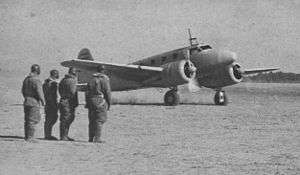Tachikawa Ki-54
| Ki-54 | |
|---|---|
 | |
| Tachikawa Ki-54 | |
| Role | Twin-engine advanced crew trainer |
| Manufacturer | Tachikawa Aircraft Company Ltd |
| Designer | Ryokichi Endo |
| First flight | Summer 1940 |
| Introduction | 1941 |
| Retired | 1945 (Japan) 1952 (China) |
| Primary user | Imperial Japanese Army Air Force |
| Produced | 1941-1945 |
| Number built | 1,368 |
|
| |
The Tachikawa Ki-54 was a Japanese twin-engine advanced trainer used during World War II. The aircraft was named Hickory by the Allies.
History
The Ki-54 was developed in response to an Imperial Japanese Army requirement for a twin-engine advanced trainer, principally for crew training. The prototype first flew in summer 1940 and, on completing trials, entered production in 1941 as Army Type 1 Advanced Trainer Model A (Ki-54a). The Ki-54a was soon followed by the Ki-54b as Army Type 1 Operations Trainer Model B and Ki-54c as Army Type 1 Transport Model C. The Ki-54b and -c enjoyed successful careers until the end of the war. A few captured aircraft were flown after the war by various users.
Operators
- Imperial Japanese Army Air Force used them for training as per their design.
- Manchukuo Air Force Three were provided by Japan as VIP transports.
- Republic of China Air Force Nationalist Chinese (captured).
- People's Liberation Army Air Force Communist Chinese (captured): Four captured Ki-54s were used, including in 1951 to train the first class of female pilots in China. They were retired in 1952.
- Armée de l'Air At least seven Ki-54 were recovered by the French in French Indochina between 1945 and 1947, after the Japanese surrender.
- One aircraft operated briefly by No. 273 Squadron RAF during September and October 1945 in French Indochina.[1]
Survivors
- A Ki-54 fuselage is in Australia in storage at the Australian War Museum Annex. It was previously part of a playground at the RAAF Fairbairn base kindergarten.[2]
- Another Ki-54 fuselage is stored in China at the Chinese Aviation Museum.[3][4]
- A Ki-54 was found at the bottom of Lake Towada in Aomori Prefecture on 13 August 2010. It was recovered on September 5, 2012[5] and has been restored for display.[6]
Variants
- Ki-54a - unarmed pilot trainer
- Ki-54b - armed crew trainer
- Ki-54c - eight-passenger light transport, communications aircraft. Civil designation Y-59.
- Ki-54d - maritime reconnaissance/ASW, carried 8x 60-kg (132-lb) depth charges
- Ki-110 - one prototype Ki-54c of all-wood construction, destroyed in US bombing attack
- Ki-111 - projected fuel tanker (none built)
- Ki-114 - projected fuel tanker of all-wood construction (none built)
Specifications (Ki-54)
Data from The Concise Guide to Axis Aircraft of World War II;[7] Japanese Aircraft of the Pacific War[8]
General characteristics
- Crew: two
- Capacity: eight
- Length: 11.94 m (39 ft 2 in)
- Wingspan: 17.90 m (58 ft 8.75 in)
- Height: 3.58 m (11 ft 9 in)
- Wing area: 40 m² (430.57 ft²)
- Empty weight: 2,954 kg (6,512 lb)
- Useful load: 943 kg (2079 lb)
- Loaded weight: 3,897 kg (8,591 lb)
- Powerplant: 2 × Hitachi Ha-13a 9-cylinder radial engine, 380 kW (510 hp) each
Performance
- Maximum speed: 375 km/h (233 mph)
- Cruise speed: 240 km/h (149 mph)
- Range: 960 km (597 mi)
- Service ceiling: 7,180 m (23,555 ft)
- Wing loading: 97.4 kg/m² (20 lb/ft²)
- Power/mass: 0.195 kW/kg (0.119 hp/lb)
Armament
4x 7.7-mm (0.303-in) machine guns, practice bombs
See also
- Aircraft of comparable role, configuration and era
- Related lists
References
| Wikimedia Commons has media related to Tachikawa Ki-54. |
- Notes
- ↑ Thomas, Andy (July 2008). "Vietnam Prelude". FlyPast. Stamford, Lincolnshire, England: Key Publishing (324): 70–71.
- ↑ "Anyone got pics of the AWM Ki-54?". Warbirdz Aviation Photography. Retrieved 15 December 2013.
- ↑ Ki-54 Hickory Manufacture Number ? Retrieved April 3, 2016
- ↑ http://www.lph2o.com Aircraft database Retrieved April 3, 2016
- ↑ September 5, 2012 Retrieved April 2, 2016 Template:Icon ja
- ↑ 旧陸軍練習機、十和田湖で発見…戦時中に墜落:社会 : YOMIURI ONLINE(読売新聞)(Japanese)
- ↑ David Mondey 1996, p. ?.
- ↑ Francillon 1979, p. 256.
- Bibliography
- Francillon, Ph.D., René J. Japanese Aircraft of the Pacific War. London: Putnam Aeronautical, 1979. ISBN 0-370-30251-6. (new edition 1987. ISBN 0-85177-801-1.)
- Mondey, David. The Concise Guide to Axis Aircraft of World War II. New York: Bounty Books, 1996. ISBN 1-85152-966-7.